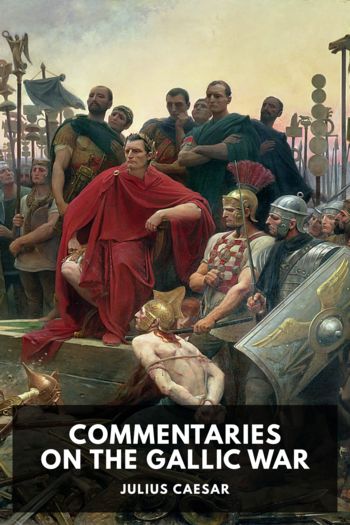Fateful Lightning: A New History of the Civil War & Reconstruction by Allen Guelzo (icecream ebook reader txt) 📗

- Author: Allen Guelzo
Book online «Fateful Lightning: A New History of the Civil War & Reconstruction by Allen Guelzo (icecream ebook reader txt) 📗». Author Allen Guelzo
That some Americans were prepared to act on that assumption was clear from what was already beginning to happen in Texas. In 1820 Spain still clung tenaciously to large parts of the New World empire it had won under the conquistadors of the 1500s. But Spain’s political strength had been ebbing for 200 years, and by 1800 it was proving more and more difficult for the Spaniards to control an American dominion that still stretched from the southern cone of South America up to the Missouri and Mississippi Rivers. One by one, pieces of that dominion in South America had thrown off Spanish rule and established republics based on the liberties and slogans of the American revolution of 1776. Then in 1820 the Spanish king, Ferdinand VII, was challenged by an uprising among his own officers, who demanded reform and a republic. While Spanish attention was preoccupied with its own revolution, the Spanish province of Mexico took its future in its own hands and established a revolutionary monarchy under Agustín de Iturbide in 1821. Iturbide’s monarchy proved only marginally more popular than Spain’s. In 1823 Iturbide was overthrown, and the following year a republic was established. 6
The Mexican republic had a rocky history, especially since the individual Mexican states had notions of independence and autonomy not unlike some of those held by their North American neighbors. At length, in 1833, an ambitious general, Antonio Lopez de Santa Anna, solved the republic’s problems by overthrowing it and setting up a personal dictatorship. In the meantime, the Mexican states dealt with their internal problems pretty much by their own lights. For the state of Coahuila, which included the province of Texas, the principal problem was the sparsity of the population. From the 1820s onward, Coahuila proposed to cure that barrenness by franchising out large, vacant stretches of eastern Texas prairie to land-hungry Americans. Guided by empresarios and land brokers such as Moses and Stephen Austin, who acted as middlemen between Coahuila and potential American settlers, large colonies of Americans migrated to Texas, some 20,000 of them by the end of the decade and 30,000 by 1835. They found under the Mexican flag a land perfectly formed for raising livestock and farming—especially cotton. And cotton meant slaves. By 1830 the Anglo-Americans in Texas already had 1,000 slaves working in the rich new cotton fields of east Texas.7
What had at first seemed like the ideal solution to the emptiness of their land soon turned sour for the Mexicans. Not only did the American colonists blithely disregard agreements that bound the colonists to convert to Roman Catholicism and adopt Spanish as the civil language, but their numbers eventually dwarfed the tiny Mexican population of Texas. Anxious that the Americans would soon attempt to set up an independent Texan government, Santa Anna attempted to seal off the Texas border with Louisiana to control further immigration. Instead, the Mexican troops, under the clumsy command of Santa Anna’s brother-in-law, provoked an uprising in Texas, and in December 1835 the enraged Texans drove Santa Anna’s men back across the Rio Grande into Coahuila.
The resulting Texan war of independence was short but spectacular. Many of the Mexican grandees of Texas had no more love for Santa Anna’s dictatorship than the American colonists did, and the Tejanos and their Anglo neighbors declared Texas an independent republic in March 1836. The odds for the Texan republic’s survival were at first not very good. Santa Anna gathered an army of 4,000 and staged a midwinter march into Texas that threw the Texans into a panic. The small Anglo-Tejano garrison in San Antonio barricaded itself into a crumbling Catholic mission known as the Alamo and held up Santa Anna’s advance for thirteen days until a predawn Mexican attack overwhelmed the Alamo’s 183 defenders. The Alamo was not particularly significant from a military point of view (the Alamo garrison had originally been instructed to blow the place up and retreat), although Santa Anna did waste the lives of a few hundred of his men in the effort to capture the Alamo. What turned the Alamo from a military annoyance into a catastrophic misjudgment was Santa Anna’s temperamental decision to put every survivor of the Alamo garrison to death. Across east Texas, the American colonists were both terrified and outraged, and “Remember the Alamo” became an electrifying war cry. A ragtag Texan army, under an old protégé of Andrew Jackson named Sam Houston, fell back before Santa Anna’s advance, lulling the Mexicans into a false sense of certain conquest. Santa Anna unwisely divided his forces in pursuit, and on April 21, 1836, Houston and the Texan army turned and struck Santa Anna’s troops at San Jacinto, routing the Mexicans and capturing Santa Anna himself. As a condition of his release, Santa Anna signed an agreement recognizing Texan independence (an agreement he promptly repudiated when Santa Anna reached Mexico City again).
The aim of the Texans, however, was not to remain independent but to join the United States as a new state as





Comments (0)